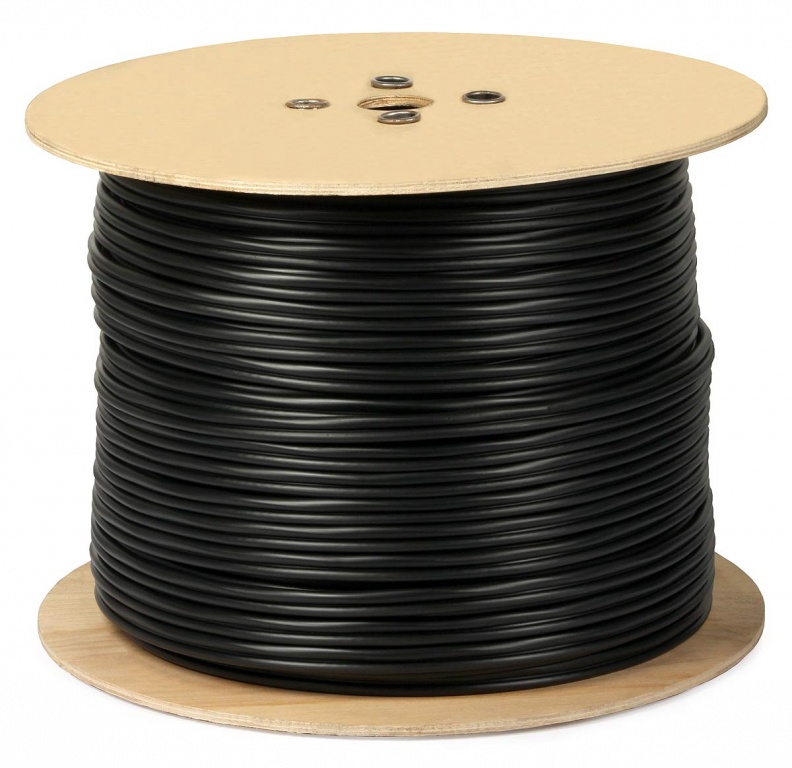| Type | RF coaxial connector | ||
|---|---|---|---|
| Production history | |||
| Designer | Eric E. Winston | ||
| Designed | Early 1950s | ||
| Manufacturer | Various | ||
| General specifications | |||
| Diameter |
| ||
| Cable | Coaxial | ||
| Passband | From 0Hz to, at least, 2.15GHz | ||
The F connector (also F-type connector) is a coaxialRF connector commonly used for 'over the air' terrestrial television, cable television and universally for satellite television and cable modems, usually with RG-6/U cable or, in older installations, with RG-59/U cable.
The F connector was invented by Eric E. Winston in the early 1950s while working for Jerrold Electronics on their development of cable television.[1] In the 1970s, it became commonplace on VHF, and later UHF, television antenna connections in the United States, as coaxial cables replaced twin-lead.
It is now specified in IEC 60169 Radio-frequency connectors, part 24[a].
- 1Description
GE RG6 Coaxial Cable Extension Adapter, 2 Pack, Works On F-Type Cables, Compatible with all BRANDS of Coax Cables, Simple Setup, Nickel Plated, 23203. Jan 08, 2016 Cable TV connector installation, RG6, RG59 snap and seal connector. Coax cable TV connector installation Spade Of All Trades. How to Install a Coax Cable F Connector with Common Tools.
- FREE 2-Day Shipping Electronics & Office Movies, Music & Books Home, Furniture & Appliances Home Improvement & Patio Clothing, Shoes & Accessories Baby Toys, Games, and Video Games Food, Household & Pets Pharmacy, Health & Beauty Sports, Fitness & Outdoors Auto, Tires & Industrial Photo & Personalized Shop Art, Craft, Sewing & Party Supplies See All Departments.
- It contains essential information to make you get the best from your new monitors. General Information COAX is a professional studio monitor for near field, designed for accurate sound realization. This loudspeaker is suitable for: – small size recording studios, – broadcasting studios, – TV studios, – multimedia studios.
- Learn more about your Comcast TV box and download the user manual here.
Description[edit]
The F connector is an inexpensive, gendered, threaded, compression connector for radio frequency signals. It has good 75 Ω impedance match for frequencies well over 1 GHz[2] and has usable bandwidth up to several GHz.
Connectors mate using a 3⁄8in-32 unified extra fine (UNEF) thread. The female connector has a socket for the center conductor and external threads. The male connector has a center pin, and a captive nut with internal threads.
The design allows for low-cost construction, where cables are terminated almost exclusively with male connectors. The coaxial cable center conductor forms the pin, and cable dielectric extends up to the mating face of the connector. Thus, the male connector consists of only a body, which is generally crimped onto or screwed over the cable shielding braid, and a captive nut, neither of which require tight tolerances. Push-on versions are also available.
Female connectors are typically used on bulkheads or as couplers, often being secured with the same threads as for the connectors. Thus can be manufactured as a single piece, with center sockets and dielectric, entirely at the factory where tolerances can easily be controlled.
This design is subject to the surface properties of the inner conductor (which must be solid wire, not stranded) and is not corrosion resistant. Hence waterproof versions are needed for outside use (for example, on antennas). Corrosion resistance can be improved by coating all bare copper wires with silicone grease.
Weatherproofing[edit]
The F connector is not weatherproof. Neither the threads nor the joint between male connector body and captive nut seal. However, male connectors are commonly enhanced with an o-ring (of about 7mm) inside the captive nut. This seals between the mating faces of both connectors, providing good waterproofing for the center conductor.
Usage[edit]
The cable and satellite television entities (as a near standard practice) use compression fittings with F connectors on customer premises. In Europe, block down-converted satellite signals (950–2150 MHz) from LNBs and DC power and block signalling from satellite receivers are near exclusively passed through F connectors.[3]

F connectors are probably the most suitable for domestic terrestrial, cable, and satellite TV installations where the delivery of very high frequency information is required. Belling-Lee connectors (IEC 169-2; used on European terrestrial receivers) are not well suited for long-haul building delivery of frequencies above 500MHz, because the standard was designed around tube receivers and mediumwave (or shortwave) antennas (but workarounds[clarification needed] exist).[4] F connectors require slightly more care to properly install the male connectors to the cable than the Belling-Lee type, with the exception of compression or flex type connections.
Flex F connectors[edit]
Push-on (aka Flex) F connectors provide poorer shielding against microwave signals of high field strength. This leakage problem is more an artifact of bent or partly broken push on connectors, but is mostly not observed with compression connectors. Nearby television, FM radio, mobile & cordless phones, government radiolocation (54–1,002 MHz)[5] transmitters can potentially interfere with a CATV or DTH Satellite reception or operation if the Flex connector poorly installed.

F connectors attached to a 4-way DiSEqC switch.
A visual collection of standard and right-angle coaxial F connectors, a commonly used but less documented form of the F connector.
Notes[edit]
- ^Radio frequency coaxial connectors with screw coupling, typically for use in 75 ohm cable networks (type F)
See also[edit]
References[edit]
- ^Electrical Connector. US Patent 3,537,065 by Eric Winston
- ^IEC 60169-24: 'Radio-frequency connectors - Part 24: Sectional specification - Radio frequency coaxial connectors with screw coupling, typically for use in 75 Ω cable networks (type F).' (2009) [1]
- ^'Understanding lnb specifications'(PDF). SatCritics Technicals. 2002-11-15. Retrieved 2017-11-29.
- ^'How to wire a Belling-Lee connector'. www.megalithia.com.
- ^Cityfreq United States Scanner Frequencies, Phone Numbers, and IP Addresses.
Cable Connectors For Tv
Further reading[edit]
- 'F' Port (Female Indoor) Physical Dimensions, ANSI/SCTE 02 2015 (see www.scte.org).